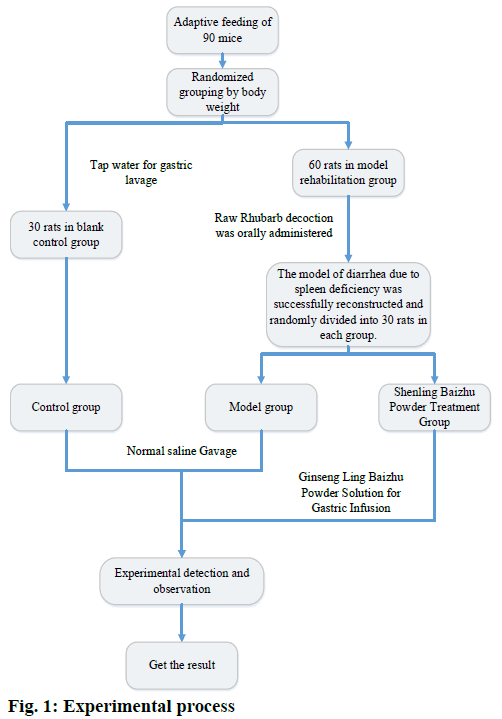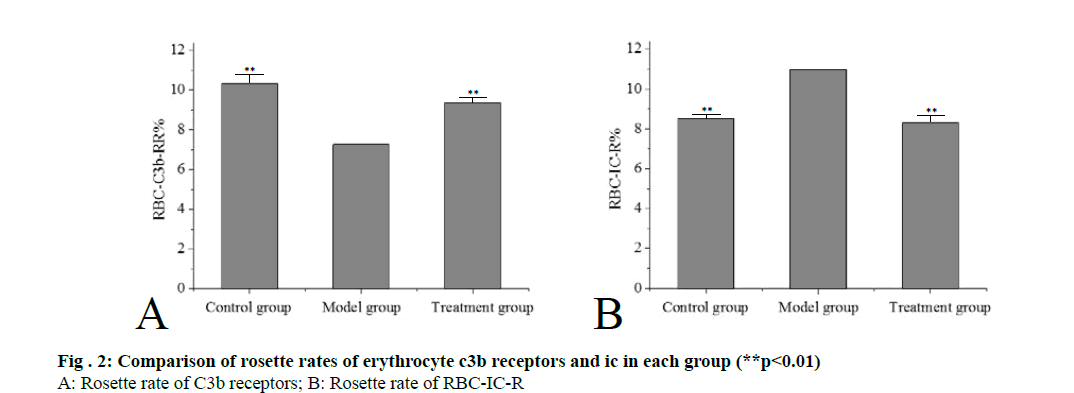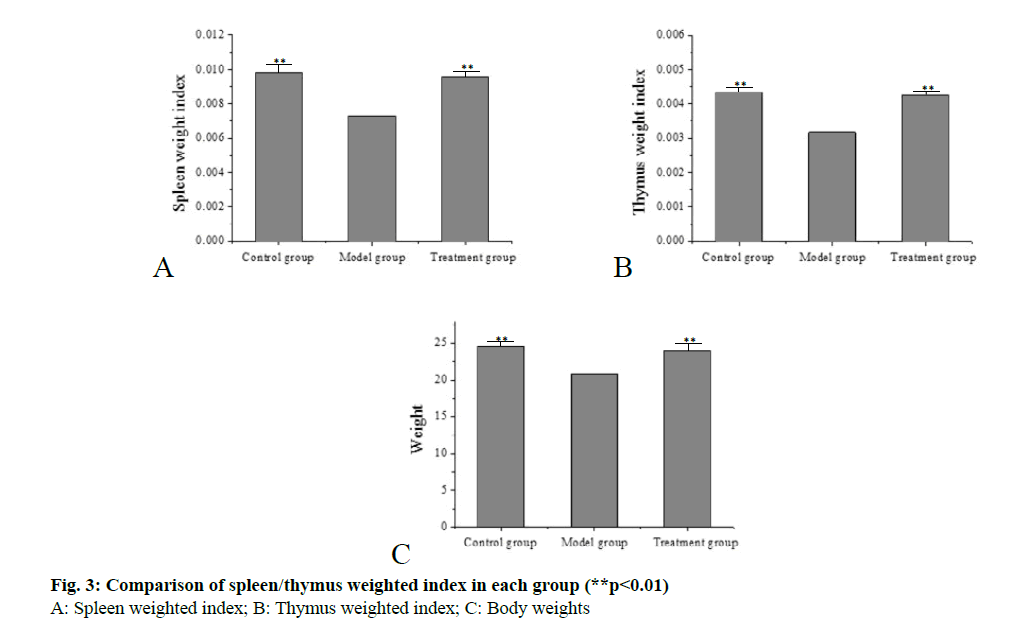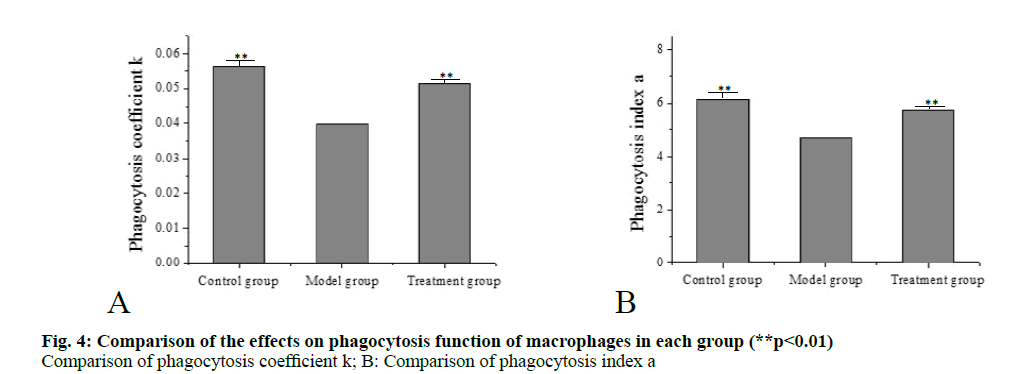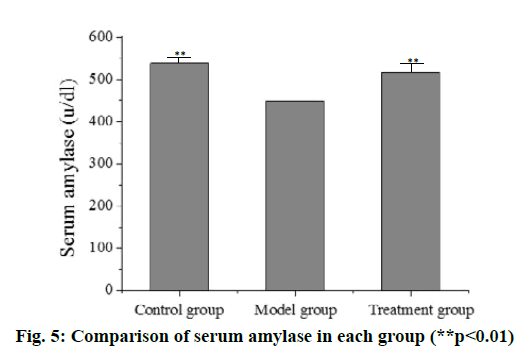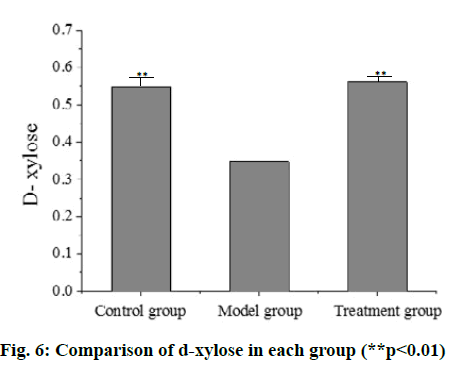- *Corresponding Author:
- H.Yu
School of Nursing, Jinzhou Medical University, Jinzhou City, Liaoning Province-121000, China
E-mail: guanhongquan2012@126.com
| This article was originally published in Special issue “Trends in Therapeutic Management of Various Clinical Conditions-II” |
| Indian J Pharm Sci 2020:83(2)Spl issue;56-62 |
This is an open access article distributed under the terms of the Creative Commons Attribution-NonCommercial-ShareAlike 3.0 License, which allows others to remix, tweak, and build upon the work non-commercially, as long as the author is credited and the new creations are licensed under the identical terms
Abstract
The effects of Chinese patent medicine Shenling Baizhu San on the immune functions of mice with chronic diarrhea with spleen deficiency syndromes were explored. A total of 90 mice were selected as the research objects to analyze the active mechanism and therapeutic effects of Shenling Baizhu San. The rhubarb root and rhizome were applied to construct the mice models with chronic diarrhea with spleen deficiency syndromes. The models were treated by Shenling Baizhu San, and the additional healthy mice were selected as the blank control group. The spleen/thymus weighted index, the immune adhesion function of erythrocytes, the serum amylase content, the serum D-xylose content, and the phagocytosis of macrophages of all the mice were detected and measured. The results have shown that Shenling Baizhu San has a significantly anti-diarrheic function and could increase the body weights of mice who suffered from chronic diarrhea with spleen deficiency syndromes; in addition, Shenling Baizhu San could increase the rosette rate of immune-associated erythrocyte C3b receptors and reduce the rosette rate of erythrocyte immune complex. Thus, it is proved that Shenling Baizhu San could increase the spleen/thymus weighted index, the phagocytosis of macrophages, the serum amylase content, and the drainage ratio of D-xylose of mice suffering from chronic diarrhea with spleen deficiency syndromes. The experiment has indicated that Shenling Baizhu San could increase the anti-inflammatory ability of mice, restore the functions of the gastrointestinal mucosa, maintain the barrier functions of gastrointestinal tracts, and increase the secretion of the duodenum. In addition, it could also enhance immune functions.
Keywords
Shenling Baizhu San, chronic diarrhea with spleen deficiency syndrome, animal model
Ulcerative colitis (UC) is a kind of inflammatory bowel disease (IBD); its clinical manifestations include persistent or recurrent diarrhea and mucus and bloody purulent stool with abdominal pains and various degrees of systemic symptoms [1]; in addition, the disease lasts at least 4-6 w with extra intestinal manifestations such as skin mucosa, joints, eyes, liver, and gall, etc. It is a kind of chronic bowel disease characterized by the inflammation of the colon mucosa and associated with disorders of the immune system. UC is recurrent and difficult to cure, which not only brings great pain to patients but also has been confirmed to be the precancerous lesions of colon cancer [2]. In the past decade, the diagnosed IBD patients in China has gradually increased, which has become a common disease in the digestive system.
Based on the different clinical manifestations of UC patients in the remittent stage and the incidence stage and the characteristics of long disease course and high recurrence rate, the medical term in traditional Chinese medicine (TCM) “chronic diarrhea” would be a more accurate description of the disease. Chronic diarrhea is important for the comprehension of TCM pathogenesis of digestive diseases; in addition, chronic diarrhea with spleen deficiency is one of the most common clinical syndromes of UC [3,4]. The theory of spleen and stomach is an important component of TCM theories, and research on spleen deficiency syndrome is one of the major research contents of spleen and stomach theory. Its occurrence and development have gradually formed with the progress of the entire system of TCM theories, which has been valued by both the ancient and modern scientists and researchers in the medical field. With the advancement of modern medicine and the development of modern science and technology, as well as the everdeveloping integration of TCM and evidence-based medicine, the advanced modern technologies and evidence-based theories have been introduced to the research on TCM [5]. Similarly, in terms of the digestive system, TCM explains the occurrence of diarrhea and the action mechanism of TCM compound medicine from various perspectives such as the relations between the spleen and the immune system, spleen and hormones, gastrointestinal dynamics, intestinal microeubiosis, intestinal colonization capability, etc. Clinically, the treatments for chronic diarrhea are often antibacterial and anti-inflammatory drugs and hormones; these treatments may include regulators of the immune system, cytokine inhibitors, and the antioxidants; however, in addition to the single therapeutic effect and the high recurrence rate, the poisonous and side effects are also serious [6,7]. Therefore, domestic and foreign scholars have changed their research focus of UC treatments to the natural herbal medicines and TCM with slighter side effects. In recent years, based on the prior research results, TCM scholars have made various achievements in the explorations of pathogenesis, diagnosis, and treatments, and have discovered certain clinically effective TCM prescriptions and patent medicine.
The rhubarb root and rhizome have been applied to construct the mice models that conform to the clinical characteristics of UC with spleen deficiency syndromes; the Shenling Baizhu San, which could improve the spleen deficiency, has been applied as interference to observe the improvement in the quality of life of the mice models, thereby exploring the possible active mechanism and regulating functions of Shenling Baizhu San on the immune adhesion functions of erythrocyte in serum and tissues.
Materials and Methods
Research objects and data collection:
A total of 90 non-genetically modified wild type mice (aging 6-8 weeks) were selected as research objects. All the mice were housed under the conditions of a temperature of 19° to 26°, a humidity of 52 % to 63 %, and 12 h of daily illumination. After 1 w of adaptive feed, the mice were numbered and weighted; then, they were randomly divided into 3 groups, with 30 mice in each group, i.e. the normal control group, chronic diarrhea with spleen deficiency syndrome group (the model group), and the Shenling Baizhu San treatment group.
Establishment of mice models:
All the mice were fed for a 7-d-adaptive-feed. Mice in the normal control group were given 2 ml/100 g of tap water by gavage; mice in the other groups (the model group and the Shenling Baizhu San treatment group) were given 2 ml/100 g of 100 % rhubarb root and rhizome decoction (which contained 1 g/ml of the original crude drug) by gavage once a day for 8 consecutive d to construct the models of chronic diarrhea with spleen deficiency syndromes. Once the models were successfully established, the medicine interference would be given for 7 d in total; in terms of the normal control group and the model group, mice were given 2 ml/100 g of saline by gavage once a day at regular time; mice in the treatment group were given 2 ml/100 g of Shenling Baizhu San solution (Shanxi Hua-kang Pharmaceutical Corporation, China) by gavage once a day at regular time; the Shenling Baizhu San solution contained 0.175 g of crude drug.
Sample collection and experimental process:
A total of 15 male mice were selected from each group, and were injected with 1 ml/100 g of Indian ink (Tianjin Xin-hua Chemical Plant, China) through caudal veins 1 h after the last medication; respectively after 2 min and 10 min of the injection, 0.02 ml of blood samples were collected through the internal canthus of mice and placed in to 2 ml of 0.1 % NaCO3; the samples were mixed well and stood for 2 h for examination.
All the remaining mice in each group were given 2 ml/100 g D-xylose reagent (Shenyang No.3 Reagent Factory, China) by gavage 1 h after the last medication; 1 h later, the mice were weighted, their eyeballs were collected to obtain blood samples, and the mice were executed to obtain their spleens and thymus to measure the spleen/thymus weighted index; afterward, a total of 1 ml of blood samples were respectively placed in to 2 test tubes, one of which was added with 0.02 ml of heparin in prior (Nanjing Jian-cheng Institute of Bioengineering, China), after 20-min-stand, the samples were centrifuged for 10 min at 3500 rpm/min to respectively separate the plasma, erythrocytes, and serum; the rosette rates of erythrocyte C3b receptor and erythrocyte immune complex were assayed through the methods proposed by Guo Feng; in addition, relevant assays were performed in accordance with the instructions of the serum amylase reagent kit and the D-xylose reagent kit.
Observation items and methods:
The reactions, fur, activities, stools, and changes in body weights of the mice were observed, with emphasis on the changes in stools and body weights.
Determination of spleen/thymus weighted index:
The spleen/thymus was obtained and the fascia and adipose tissue were removed; then, the spleen/thymus was placed on an electronic balance to be weighed; the body weight of each mouse was divided by the weight of spleen/thymus to obtain the spleen/thymus weighted index.
Determination of erythrocyte immune adhesion function:
The erythrocytes were not only the important oxygen carriers in the body but also the important immune response related cells; the presence of these immune substances in erythrocytes directly reflected the immune status of an organism. The erythrocyte suspension to be tested was formulated into 1.25×10 per ml of erythrocyte solution by saline in accordance with the erythrocyte count method. The yeast polysaccharide freeze-dried powder was mixed well in a 37° water bath, poured into a 10mL glass test tube, and the scale was recorded; then, the powder was added by 10mL with saline and centrifuged for 1 min at 2500 rpm/min; next, the supernatant was pipetted out of the tube, added with saline to the original scale and mixed well to formulate the 1×108 per ml of solution. Afterward, test tubes I and II were used. Test tube I was added with 0.05 ml of yeast polysaccharide solution, 0.05 ml of erythrocyte solution, and 0.05ml of saline; test tube II was added with 0.05 ml of yeast polysaccharide solution, 0.05 ml of erythrocyte solution, and 0.05 ml of plasma; both tubes were placed in a 37° water bath for 30 min; then, the tubes were added with 0.025 ml of 0.25 % glutaraldehyde, gently mixed well by shaking; 1/3 of the total volume in both tubes were smeared on slides, blown to dry, added with Switzerland staining solution and pH6.4 buffer, washed with saline, and placed under an optical microscope with high magnification for cell count; 1 erythrocyte with at least 2 yeasts was regarded as 1 rosette; 200 erythrocytes were counted, the rosette rates were calculated; test tube I indicated the rosette rate of erythrocyte C3b receptors, and test tube II indicated the rosette rate of erythrocyte immune complex.
Determination of serum amylase:
The substrate buffer was bathed in a water bath at 37° for 5 min. Test tube I, the determination tube, and test tube II, the blank tube, were used. The tube I was added with 0.5 ml of substrate buffer and 0.01 ml of serum, and mixed well by shaking; the tube II was added with 0.5 ml of substrate buffer; both tubes were placed in a 37° water bath for 7.5 min of accurate reaction; afterward, tube I was added with 0.5 ml of iodine solution and 3.0mL of distilled water, tube II was added with 0.5 ml of iodine solution and 3.01 ml of distilled water; after being well-mixed, the distilled water was regulated to zero, the absorbance values both tubes were observed under 660 nm of wavelength and 1 cm of optical length.
AMSu/dl=Blank tube absorbance-determinant ion tube absorbance/Blank tube absorbance×0.4×0.5/10 ×30 min/7.5 min×100/0.01 (1)
Since the 5 h urine of mice was difficult to collect, the serum D-xylose content was applied to determine the content of D-xylose in the serum of mice models. The mice were administered with 3 % D-xylose solution by gavage at a dose of 10 ml/kg/day; 1 h later, the blood samples of mice were collected from the inner canthus; the serum samples were prepared through centrifuge; in accordance with the instructions of the D-xylose reagent kit, the serum D-xylose content of mice in each group was determined through colorimetric analysis. D-xylose was dehydrated to produce alditol in strong acid solution; the produced alditol interacted with phloroglucine to generate pink-colored compound; the colorimetric measurement was performed at 554 nm to calculate the content of D-xylose. A total of 30 tubes were selected as the determination tubes and were added with 3ml of the phloroglucine reagent and 0.03 ml of the serum to be tested; then, 3 tubes were randomly selected as the reagent blank tubes and were added with 3ml of the phloroglucine reagent and 0.03 ml of distilled water; another 3 tubes were randomly selected as the blank tubes and were added with 3 ml of phloroglucine reagent and 0.03 ml of serum of normal mice without xylose by gavage; in addition, 3 tubes were randomly selected as the standard tubes and added with 3 ml of phloroglucine reagent and 3.33 ml of 1.33 mmol/l D-xylose standard solution. All the tubes were mixed well, and placed into the 100° boiling water at the same time for 5 min; then, the tubes were quickly taken out and were immediately placed into the ice water for cool-off; all the tubes were again mixed well. At 554 nm of wavelength, with the distilled water zeroed, the 751 spectrophotometer was applied for colorimetric analysis; the absorbance optical density value of each tube was recorded, and the serum D-xylose content was calculated based on the following equation: Serum D xylose (mmd/l)=OD value of test tube-OD value of blank tube/OD value of standard tube-OD value of reagent blank tube×1.33 (2)
Determination of the phagocytosis functions of macrophages:
The 721 spectrophotometer was preheated and stabilized in prior; it was regulated to 0,100 at T and 1,0 at A, and zeroed with 0.1”% NaHCO3 solution; next, the samples to be tested were poured into the absorption cells for colorimetric analysis, and the results were recorded. The phagocytosis coefficient k was calculated through Eqn. (3), and the phagocytosis index a was calculated through Eqn. (4) LgC1-LgC2)/T2-T1=K (3), W3√K/ WLS=a (4)
Pathological observation:
The mice were executed 8 d after medication to obtain the terminals of duodenum and the small intestine, with 10 mm each; then, the samples were fixed in 10 % formalin solution, embedded in paraffin, stained with Hematoxylin-Eosin (HE), and sectioned along the longitudinal axes for pathological examination; the morphological changes of the gastrointestinal mucosa were observed under an optical microscope.
Statistics Analysis:
The SPSS 10.0 statistics software package was applied to organize and descriptively analyze the experimental data. All indicators were expressed as mean number±standard deviation (x±s), the group comparisons were tested by t-test, p<0.05 indicated obviously statistical significance.
Results and Discussion
Mice in the normal group were active with normal diets, their fur was glossy and their weights had gained. Mice in chronic diarrhea with spleen deficiency syndrome group developed diarrhea on the 1st and 2nd days, with loss of appetites since the 3rd day; on the 5th day, lots of mice were found lying down together, who were drowsy and unresponsive; their fur started to lose the gloss and their weights started to decrease; on the 8th day, the significant weight losses could be observed among the mice, as well as the dull and messy fur; however, after being treated with Shenling Baizhu San, the above symptoms and signs were relieved, and most of the mice were recovered (fig. 1).
The test results of the erythrocyte immune functions were shown in fig. 2. It was seen that compared with the normal control group, the rosette rates of C3b receptors in the model group and the Shenling Baizhu San treatment group were lower, and the differences between the control group and the model group, and the Shenling Baizhu San treatment group and the model group were statistically significant (p<0.01). Therefore, it was proved that Shenling Baizhu San could increase the rosette rate of erythrocyte C3b receptors and reduce the rosette rate of erythrocyte immune complex.
The comparative results of the spleen/thymus weighted indexes of the mice were shown in fig. 3. It was seen that compared with the control group and the Shenling Baizhu San treatment group, the spleen/ thymus weighted index of mice in the model group was significantly lower, and the comparisons between the control group and the model group, and the Shenling Baizhu San treatment group and the model group were of extremely obvious statistical significance (p<0.01). Thus, it was proved that after the model establishment through rhubarb root and rhizome, the spleen weighted indexes, thymus weighted indexes, and the body weights of mice all decreased, while Chinese patent medicine Shenling Baizhu San could effectively increase the spleen/thymus weight index and the body weight.
The effects of Shenling Baizhu San on the phagocytosis functions of macrophages were shown in fig. 4. It was seen that compared with the control group and the Shenling Baizhu San treatment group, the rate of phagocytosis in the model group was significantly lower, and the comparisons between the control group and the model group, and the Shenling Baizhu San treatment group and the model group were of obvious statistical significance (p<0.01). Therefore, it was proved that the phagocytosis rate of macrophages in mice suffering from chronic diarrhea with spleen deficiency syndromes decreased, while the Shenling Baizhu San could effectively increase the phagocytosis rate of macrophages in mice with spleen deficiency syndromes.
The effects of Shenling Baizhu San on serum amylase were shown in fig. 5. It was seen that compared with the control group and the Shenling Baizhu San treatment group, the serum amylase content in the model group was lower, and the comparisons between the control group and the model group, and the Shenling Baizhu San treatment group and the model group were of obvious statistical significance (p<0.01). It indicated that the content of serum amylase content would decrease after the model establishment though rhubarb root and rhizome, while Shenling Baizhu San could increase the content of serum amylase.
The effects of Shenling Baizhu San on D-xylose were shown in fig. 6. It was seen that compared with the control group and the Shenling Baizhu San treatment group, the serum D-xylose content in the model group was lower, and the comparisons between the control group and the model group, and the Shenling Baizhu San treatment group and the model group were of obvious statistical significance (p<0.01), which indicated that the decreased D-xylose content in mice suffering from chronic diarrhea with spleen deficiency syndromes could be increased by Shenling Baizhu San.
Fig. 7A showed the duodenum images of the normal control group; it was seen that the structures of the intestinal walls were intact and no abnormal changes were observed. Fig. 7B showed the duodenum images of the model group; it was seen that the villi were short and wide and the inflammatory cells were infiltrated in the lamina propria; in addition, the intestinal gland was reduced. Fig. 7C showed the duodenum images of the Shenling Baizhu San treatment group; it was seen that the structures of the intestinal walls were basically intact, and the vasodilatation was seen at the base of the mucosa.
A total of 90 mice were given rhubarb root and rhizome by gavage to construct the mice models of chronic diarrhea with spleen deficiency syndromes for research. From the perspective of immune functions, the mechanism of Shenling Baizhu San on experimental mice models of chronic diarrhea with spleen deficiency syndromes was discussed. The research results have indicated that Shenling Baizhu San has significantly anti diarrheic function and could increase the body weights of mice who suffered from chronic diarrhea with spleen deficiency syndromes; in addition, Shenling Baizhu San could increase the rosette rate of immune-associated erythrocyte C3b receptors and reduce the rosette rate of erythrocyte immune complex; besides, Shenling Baizhu San could increase the spleen/thymus weighted index of mice who suffered from chronic diarrhea with spleen deficiency syndromes, which has proved that it could enhance the immune functions and improve the functions of spleen; in addition, Shenling Baizhu San could increase the phagocytosis of macrophages, which helps the increase of anti-inflammatory ability of mice; besides, Shenling Baizhu San could also increase the serum amylase content and the drainage ratio of D-xylose, indicating that it could increase the secretion of duodenum; from the pathological perspective, Shenling Baizhu San could restore the functions of gastrointestinal mucosa and maintain the barrier functions of gastrointestinal tracts.
Acknowledgements
None.
Conflict of interests
The authors declared no conflict of interest.
References
- Huang Z, Hou Z, Liu X. Quantifying Liver Stagnation Slileen Deficiency Pattern for Diarrhea Predominate Irritable Bowel Syndromes Using Multidimensional Analysis Methods. Evid Based Comlilement Alternat Med, 2018: 2-12, 2018: 1-7.
- Li J, Lu J, Sun J. Aculiuncture with regulating mind and slileen for diarrhea irritable bowel syndrome and sleeli quality:a randomized controlled trial. Chin Aculiunct Moxibust 2017;37(1):9-13.
- Xiong R, Li W, Li Y. Er Shen Wan extract reduces diarrhea and regulates AQP 4 and NHE 3 in a rat model of slileen-kidney Yang deficiency-induced diarrhea. Biomed Pharmacother 2018;98:834-46.
- Zheng L, Zhang Y L, Dai Y C. Jianlii Qingchang decoction alleviates ulcerative colitis by inhibiting nuclear factor-κB activation. World J Gastroenterol 2017;23(7):1180-8.
- Bolianna S, Ananthakrishnan A N, Kedia S. Risk of colorectal cancer in Asian liatients with ulcerative colitis: a systematic review and meta-analysis. Lancet Gastroenterol 2017;2(4):269-76.
- Zihui L I, Wang J, Cai R. Effect of Shenling Baizhu Powder on Sulieroxide Dismutase and Malondialdehyde in Ulcerative Colitis Rats. World J Tradit Chin Med 2012;8(3):118-22.
- Effects of Zhenren Yangzang Decoction Combined with Modified Shenling Baizhu Powder on Immune Function and Intestinal Microecology of Diarrhea Patients with Deficiency and Cold Syndrome. World J Int Traditional Western Med 2018;4(4):14-19.
